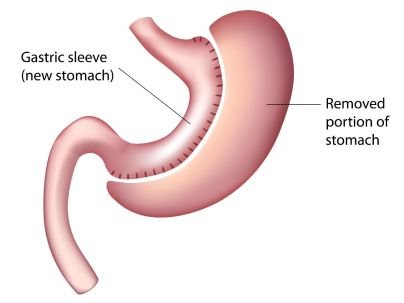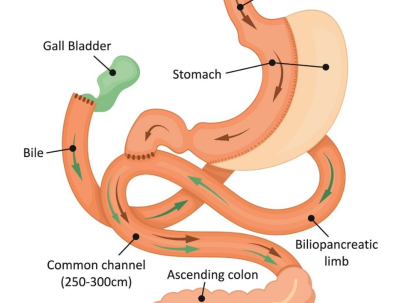Resource
The four types of bariatric surgeries performed at Richmond Metabolic and Bariatric Surgery Clinic
We offer four types of bariatric surgeries: VSG, RNY, BPD-DS and SADI-S. We do not offer lap bands or other types of surgeries.

Laparoscopic vertical sleeve gastrectomy (VSG)
The Vertical Sleeve Gastrectomy involves several small incisions in your abdomen. A vertical incision is then made to remove approximately 80-85% of your stomach. Your new stomach sleeve, shaped like a tube, holds approximately 100 -125ml l in the beginning. This new smaller stomach significantly reduces the amount of food and calories consumed. It also causes favourable changes in gut hormones which help to suppress your appetite, improve the feeling of satiety (or fullness) soon after eating, and improve blood sugars.

Laparoscopic gastric bypass (RNY)
Your laparoscopic surgery will involve six small incisions in your abdomen. A small pouch about the size of a large egg is made at the top of your stomach, and then your small intestine is divided just past your stomach. One end of the intestine is attached to your new stomach pouch, and the remainder of your stomach is bypassed (food no longer travels through this remnant stomach) though it remains in your body. The other end of your divided intestine (the one attached to your remnant stomach) is reattached to your small intestine further down. This allows for digestive juices and enzymes to meet with the food stream. This procedure reduces the size of your stomach and how much food you absorb by bypassing part of the small intestine. This is considered the Gold Standard for bariatric surgery as there is significant weight loss and improvements in obesity-related illnesses such as diabetes, high blood pressure, heart disease, GERD, etc.

Laparoscopic single anastomosis duodeno-ileal bypass with sleeve gastrectomy (SADI-S)
This procedure is a modified version of the Duodenal Switch (described in detail in the next section). The duodenum is detached just below the stomach and reattached to a loop of the small intestine about 3.6 meters downstream. This creates two separate pathways and one common channel. The shorter pathway (digestive channel) allows food to flow from the stomach to the common channel. The longer pathway (biliopancreatic channel) carries bile from the liver to the common channel. This diversion limits the time that food mixes with digestive juices and reduces the number of calories that can be absorbed, leading to weight loss.

Laparoscopic biliopancreatic diversion-duodenal switch (BPD-DS)
Biliopancreatic diversion with duodenal switch (BPD/DS) or simply duodenal switch (DS) is a bariatric surgery that can help patients lose up to 80% of their excess body weight. It is performed laparoscopically and often done as a single stage surgery but can also be done for patients that have had a VSG in the past and still have significant weight to lose or struggling with comorbidities such as, DM2, HTN, dyslipidemia, etc. It can help you lose weight and improve your comorbidities by its malabsorptive action via reducing the absorption of macro- and micronutrients (vitamins and minerals). In this surgery, the intestine is bypassed from below the pylorus to the ileum, 50 to 125 centimetres from the colon. The bypassed portion of the intestine (biliopancreatic limb) delivers bile and pancreatic juices to the anastomosis at the ileum, where it meets the alimentary limb (proximal duodenum, through which food passes) to form the common channel. This is where food combines with bile and pancreatic juices for the first time, and most nutrient absorption occurs.

